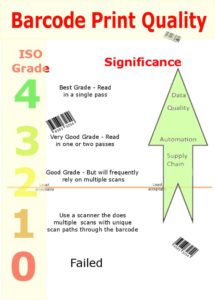Barcode costs
Did you ever wonder ‘How much does a bar code cost’?
Take a guess. 5 cents? 10 cents? More? Much more?
Want a hint? Think Value!
 It is on everything. It is one of the technologies given credit for our impressive productivity improvements. And, it is one of the key enabling technologies needed for our data driven futures. So, you wonder, how much does it cost?
It is on everything. It is one of the technologies given credit for our impressive productivity improvements. And, it is one of the key enabling technologies needed for our data driven futures. So, you wonder, how much does it cost?
Barcode started out as being virtually free. It did not cost much to put a little bit more information on a package. It became popular and then ubiquitous. The massive amounts of data generated by barcodes changed how things were done, became more important to our well being, our everyday life and hence, very valuable. New processes, new standards and new expectations were developed around the technologies. Now, it is definitely here to stay.
 Back to the cost. It turns out that the cost of a barcode is actually relative to what you get out of it. For those using all that valuable data, the cost to them is related to the loss of the data rather than the cost to print the barcode. On an auto assembly line, it could cost $30,000 per minute when a barcode stops the line. In a medical laboratory, a poorly barcoded sample costs over $700 to correct, not accounting for the patient safety or litigation costs. Think about your situation.
Back to the cost. It turns out that the cost of a barcode is actually relative to what you get out of it. For those using all that valuable data, the cost to them is related to the loss of the data rather than the cost to print the barcode. On an auto assembly line, it could cost $30,000 per minute when a barcode stops the line. In a medical laboratory, a poorly barcoded sample costs over $700 to correct, not accounting for the patient safety or litigation costs. Think about your situation.
 More often than not, the person printing the barcode is not the person who benefits from the data. Printing is considered an insignificant task in many companies. The people printing do not always understand the importance of what they are doing or the consequence of doing a poor job. Many do not even know that there is a standard that they are supposed to comply with, how to check barcodes for quality,[i] or have the proper tools.
More often than not, the person printing the barcode is not the person who benefits from the data. Printing is considered an insignificant task in many companies. The people printing do not always understand the importance of what they are doing or the consequence of doing a poor job. Many do not even know that there is a standard that they are supposed to comply with, how to check barcodes for quality,[i] or have the proper tools.
Barcode print quality standards were introduced in 1990. They help printers produce barcodes that can be scanned anywhere by virtually any scanner. There are now many millions of individuals printing barcodes every day, around the world. And there are now thousands of different scanners out there, any of which could be trying to scan your barcodes. Think about your situation. Do you know how well you are doing? How your customer uses your barcode (the value to them, the cost to you if they can’t read it)?
If you are one of the data users, then there are a few things you can do to meet your data objectives, productivity objectives and keep your costs down.
- Make sure your purchasing contracts always specify that vendors must at least meet industry standard minimum barcode print quality (for retail, healthcare, defense, electronics, etc. this is usually an ISO Grade 2 or better). This is one of the ways you can let the supplier know it is important.
- Inspect incoming product or packaging materials for barcode print quality before acceptance. If you accept bad product and add value then it becomes harder to correct.
- Include barcode print quality into your vendor evaluation and compliance requirements. It really is an important part of the product. It has to be right.
- Audit with a focus on inventory items that seem misaligned. “Invisibility” is an indication of barcode problems.
- Work with vendors to identify problems and collaborate with fixes but…remember that the printer is responsible for the quality. They should have the tools to do a good job for you. Do not accept “Well, it scanned over here!”. That doesn’t mean anything. Ask for the inspection records of barcode print quality.
- Look for proactive quality control from vendors. You should not be receiving untested barcodes
- Chargeback as necessary to recover costs
If you are one of the barcode printers, then there are a few things you can do to keep your customers and keep your costs down.
- Do not assume your barcode print quality is good because ‘ I haven’t had any complaints’. That does not mean you are producing good barcodes. If you want to hear about some of the instances where companies found this out the hard way just give us a call.
- Do not use a scanner to ‘check’ barcodes. That will not work. The only tool that can check barcodes is called a barcode verifier. It is quite different than a scanner and can help you make sure your barcodes can be read by all customers around the world, easily and accurately.
- Establish processes to insure you do not make and/or ship untested batches of barcodes. One bad batch may be one batch too many.
- Start thinking about barcode quality as a ‘value’ you are providing to your customers, not an insignificant aspect of what you are supplying. Build it into your culture, do it right and be happy you are an important part of your customers information systems. Doing it right will not increase your cost to barcode.
More at www.scanalyst.com or www.goodbarcodes.com
[i] The testing method is called Barcode Verification and can be used to ensure compliance. To learn more you can look up ISO 15416 or click www.scanalyst.com
